Choosing the right solar lanterns can feel like navigating a garden maze at dusk—so many paths, but which one leads to a brighter, greener future? Whether you’re setting the mood for your backyard oasis or prepping for an off-grid adventure, solar-powered lanterns offer an eco-friendly solution that cuts down on energy costs while reducing your carbon footprint.
But it’s not just about picking the brightest light. It’s about choosing brands that align with your values—those that prioritize sustainability, durability, and ethical manufacturing. This guide doesn’t just showcase the best solar lanterns; it dives deeper into the brands behind them, highlighting their eco-friendly practices and how they’re reshaping outdoor lighting for a cleaner planet.
Plus, if you’re feeling a little lost in the glow of options, stick around for our comprehensive buying guide—it’s packed with tips to help you find the perfect solar lantern for your space and needs.
Brighten Your Space Sustainably with These Top Solar Lantern Brands
1. LuminAID: Shining a Light on Humanitarian Aid and Clean Energy
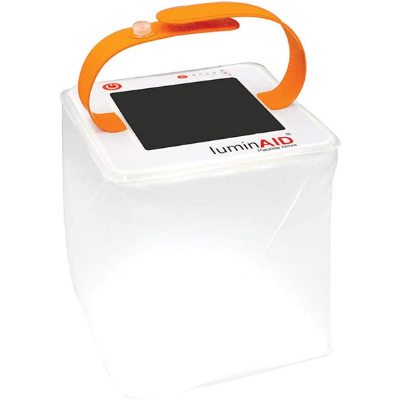
LuminAID isn’t just about outdoor lighting—they’re about bringing light to those who need it most. Founded by architecture students after the 2010 Haiti earthquake, the brand focuses on solar-powered lanterns designed for disaster relief and outdoor adventurers alike. Their compact, inflatable designs are made to be lightweight and durable, cutting down on shipping emissions and storage space.
LuminAID takes sustainability seriously—using clean, renewable solar energy to power their lights, reducing reliance on disposable batteries or fossil fuels. Their Give Light Get Light program donates lanterns to families living without electricity, directly impacting global energy poverty. Plus, they’re actively involved in disaster response, making sustainability about more than just products—it’s their mission.
For conscious consumers seeking eco-friendly lighting that does real-world good, LuminAID is a beacon of ethical innovation.
2. TomCare: Crafting Ambiance with Recyclable Materials
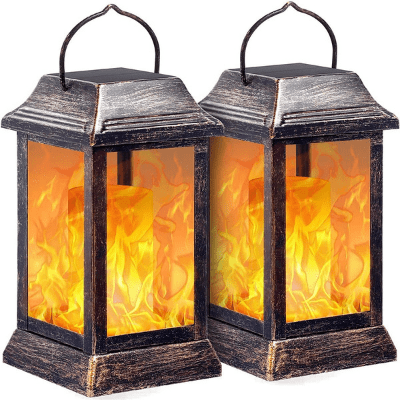
TomCare is all about blending elegant design with eco-friendly function. Known for their flickering flame-style solar lanterns, they focus on creating warm, atmospheric outdoor lighting without the carbon footprint of traditional lanterns.
Their products emphasize durability and recyclability, with many lanterns made from weather-resistant metals and plastics. While TomCare doesn’t lead with a sustainability-first brand message, their focus on long-lasting, solar-powered lights supports eco-friendly outdoor living by reducing energy consumption and battery waste.
For homeowners seeking stylish, energy-efficient garden lighting, TomCare’s lanterns offer a balance of aesthetics and low-impact living.
3. MAGGIFT: Affordable Solar Lighting with a Focus on Longevity
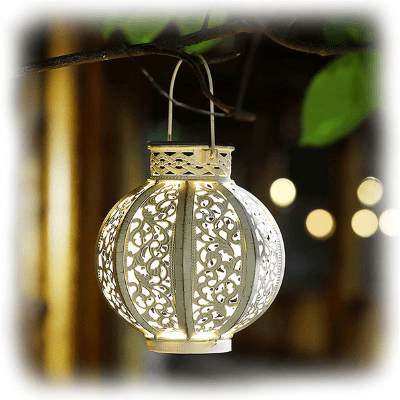
MAGGIFT positions itself as the go-to for affordable, reliable solar lighting—from garden stakes to lanterns. Their products focus on weather resistance and extended battery life, offering sustainable lighting solutions that last through the seasons.
While the brand doesn’t wear its eco-values on its sleeve, solar-powered functionality is at the heart of every MAGGIFT lantern, cutting down on electrical use and disposable battery waste. Their emphasis on durable materials ensures a longer product life, reducing the need for frequent replacements that add to landfill overflow.
For budget-conscious buyers seeking reliable, solar-powered lanterns, MAGGIFT delivers simple sustainability.
4. Pearlstar: Simple, Rustic, and Solar-Driven
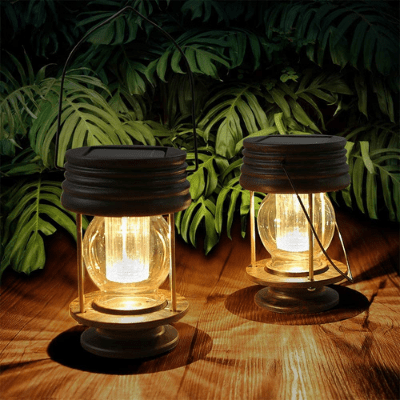
Pearlstar brings a rustic charm to solar lanterns, with designs that blend seamlessly into gardens and patios. Their solar-powered lights are made with weather-resistant materials like iron and glass, ensuring they stand up to the elements and last for years.
While not aggressively marketed as a green brand, Pearlstar’s commitment to solar technology helps homeowners reduce energy consumption and avoid disposable battery waste. Their focus on recyclable materials like metal and glass further supports eco-conscious consumers looking for sustainable decor.
For those who appreciate vintage aesthetics with modern eco-friendly tech, Pearlstar’s lanterns light the way.
5. OxyLED: Tech-Savvy Lighting with Green Credentials
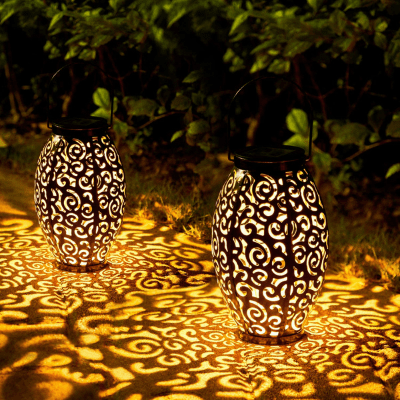
OxyLED merges smart technology with solar efficiency. Known for integrating motion sensors and advanced LED tech into their lanterns, they optimize energy usage while maintaining bright, functional lighting.
Their solar-powered lanterns help reduce reliance on grid electricity, cutting down on carbon emissions. While their sustainability messaging isn’t front and center, the use of recyclable materials and energy-saving designs aligns with eco-friendly principles. OxyLED products are built for durability and performance, reducing replacement cycles and contributing to waste reduction.
For tech enthusiasts seeking energy-smart, solar-powered lighting, OxyLED offers a modern, low-impact choice.
6. Ulmisfee: Cozy Aesthetics Meet Renewable Energy
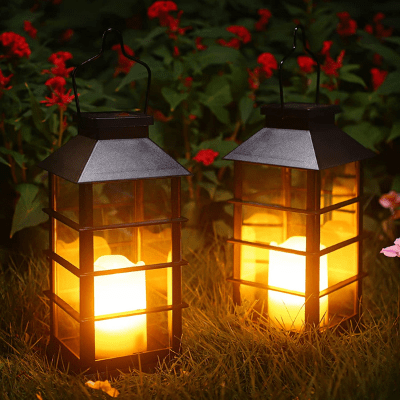
Ulmisfee specializes in decorative solar lanterns that bring a cozy glow to outdoor spaces. Their designs favor metal and glass construction, ensuring recyclability and durability.
The brand keeps its environmental impact low by leveraging solar power exclusively, reducing dependence on electricity or disposable batteries. While they don’t actively market sustainability initiatives, their product life cycles speak for themselves—sturdy materials mean fewer replacements, less waste, and more reliable outdoor lighting.
For anyone seeking charming, long-lasting solar lanterns with subtle sustainability baked in, Ulmisfee is a solid pick.
7. Cooo: Minimalist Design with Maximum Solar Power
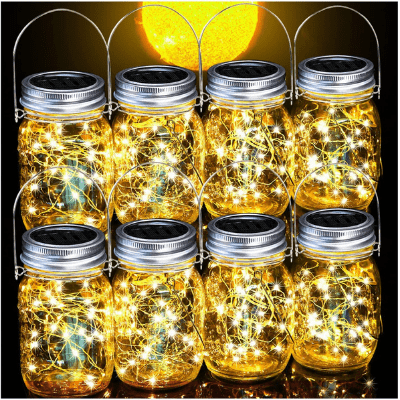
Cooo takes a minimalist approach to solar lighting, offering sleek designs that focus on simplicity and function. Their solar-powered lanterns use durable materials like stainless steel and weather-resistant plastics, extending product life and reducing environmental impact.
Although their sustainability messaging is understated, the commitment to solar technology and durability-first manufacturing supports an eco-conscious lifestyle. By creating lanterns that last, Cooo helps minimize waste and reliance on non-renewable energy.
For fans of modern, understated design who want to light their spaces sustainably, Cooo is a clean, green option.
8. TANSOREN: Rugged Solar Lanterns for Outdoor Adventures
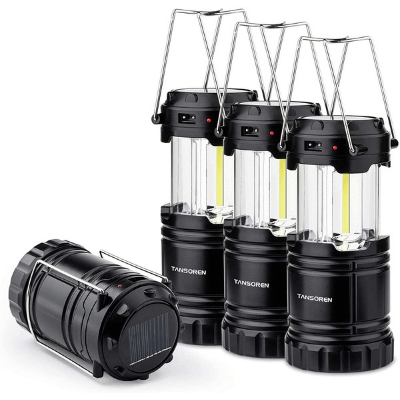
TANSOREN is geared toward outdoor enthusiasts and emergency preparedness, offering multi-functional solar lanterns that double as power banks. Their focus on versatility and durability makes them ideal for camping, hiking, and emergency kits.
Sustainability comes through solar charging and long-lasting LED technology, reducing reliance on disposable batteries and fuel-based lighting. Though they don’t push eco-marketing hard, their durable construction ensures products survive rough conditions, minimizing waste through longevity.
For eco-conscious adventurers seeking rugged, reliable lighting, TANSOREN’s lanterns deliver renewable energy where it counts.
What To Look For When Buying a Solar Lantern
Design
Choosing the best lamp design can add classiness and elegance to your patio, garden, or backyard.
You can choose between different designs, such as:
- Modern Lanterns
- Vintage Lanterns
- Traditional Lanterns
LED Lights vs Conventional Lights
You’re not sure which ones have better features? Here’s why you should choose LED lamps:
- LED lighting design is more environmentally friendly
- Running and maintenance costs are low or free as solar LED lanterns use the sun’s energy
- Solar LED bulbs are brighter than conventional ones and provide even illumination
- Solar LED bulbs are safer, as they have no wires attached to them
Number of Lumens
Are you hosting a yard or garden party or you need a backup light during extreme weather conditions where solar lanterns are your only source of light?
Depending on what you’ll use the lanterns for, think about the brightness intensity.
When choosing a lantern for you, bear in mind that a lot of them have a decorative function and aren’t intended for lightning purposes. This means the light intensity won’t be very high.
Average lanterns have between 5 and 40 lumens. However, if solid lighting is your main goal, go for a LED lantern that has more lumens and can give you more illumination.
Charging Options
Choose solar lights with shorter charging and a longer working time.
If you live in an area where there isn’t a lot of direct sunlight, go for a lantern whose features include a combination of a battery and a solar panel. In this way, no matter the weather you find yourself in, you’ll be able to charge your product.
Pro tip: If you don’t have a good outdoor solar resource available, choose a battery with a low capacity type, as this will give you more time to charge it to the fullest, which will optimize its performance.
Location
To get the most of your solar-powered lantern, you should use it in a region that gets plenty of sunlight.
If, however, you live in a cloudy place, choose a lantern that uses an amorphous solar panel.
Pro tip: Ensure that the solar cell isn’t shaded by foliage or surrounding structures, which can interfere with the charging.
Maintenance and Lantern Materials
Using sun energy equals easy solar lantern maintenance. Solar products generally don’t have a lot of moving parts, which means it’s easy to clean them.
To not worry about lantern damage, choose a quality material. Go for a high-quality plastic that doesn’t sustain exposure to direct sunlight. If there are any metal parts, they should be stainless steel to ensure the lantern won’t rust because of moisture.
In case you go for a glass lantern, choose the kind of glass that won’t fade or frost as this will affect the lighting quality.
Weight
We know that string lights will add that magic touch to your garden, but they might not be the best choice.
Over time, the string will become thin and break, which will cause solar lights to fall and break.
Also, to make the hanging lights last longer, go for a lightweight lantern instead of a heavyweight one.
Pro tip: Instead of buying lanterns on a string, choose ones that have hooks. This way, you can choose where you want to hang your lights.
Emergency Situations
It’s essential to have a reliable lighting source in times of crisis and emergencies. The last thing you want is to get stuck during a blackout without adequate lighting for your family.
Solar-powered lamps that are also a LED lantern is a great choice:
- For night lighting purposes — Being able to illuminate your environment at night is key to survival in emergency situations
- Emergency backup — If systems fail during extreme weather you’ll have a back-up lighting source
- Safer alternative — A candle lantern, or camping lanterns, are safer alternatives than kerosene lamps or open-flame candles
How Do Solar Lanterns Work?
A lantern is made of:
- Battery
- Light fixture
- Controller board
- Four cell solar array
- Photoresistor
The solar cells are wired to the battery through a diode. During the day, the battery charges.
The controller board accepts energy from the solar cell and battery, as well as input from the photoresistor. Once the photoresistor indicates darkness, the controller board turns on the light fixture.
For the lantern to work correctly, its placement is important. Position the solar cell south at an angle perpendicular to the sun to make the most out of it.
Why Invest in Solar Lanterns?
A Renewable Source of Light
Solar power is renewable and items that use it are more eco-friendly than items that use electricity.
The sun always rises, so you’ll never worry about running out of energy, which can’t be said for other finite sources.
Also, solar energy is readily available and doesn’t harm the planet.
Solar Light Will Save You Money
They pay off in the long run.
We all know how pricey electricity is, but energy from the sun is free. Whether you want to light up your patio, garden, yard, or you need a lantern for camping, using the sun to charge energy-consuming items will save you a pretty buck.
Mobility
Pick up your UV light products and place them wherever you want. If any part of your space doesn’t have tons of sunlight, it’s easy to reposition the solar lantern.
You need to take your dog out in the middle of the night? A solar lantern will give you all the light you need wherever you go.
Solar Lights are Safe
Solar lanterns don’t have any external cords or wiring to worry about.
You don’t have to worry about your child or pet being electrocuted or tripping on these cordless lights.
Finally, they don’t overheat. Their design is safe to use.
Frequently Asked Questions (FAQ)
Yes, solar lights are worth the money. They’re budget and environmentally friendly, can add ambiance to your yard, and stay on for 8 hours. All you have to do is position them where you want them to be.
Solar lanterns last for 3-4 years before you have to replace the battery. The LEDs last even longer, up to 10 years. Those that have a build made of stainless steel will also last for a long time.
Solar lights don’t need the sun to charge. Just place the lights under artificial lights and it will charge speedily, without any sunlight.
Yes, it’s OK to leave solar lights on all night long, but be aware that come morning chances are after about 8 hours the lantern will be empty, and you’ll have to charge it.
Yes, solar lights will stay on all night unless you turn them off, based on the energy they have stored during the day.If the battery is in good condition the LED bulb should have enough energy to illuminate all evening and night — starting from sunset until the next morning.
You can make your solar lights stay longer by regularly cleaning them, changing the expired battery regularly, putting them in a location with direct sunlight, or turning them off on a rainy day.
Yes, rain can ruin solar lights. If it rains continuously, the panels can’t charge efficiently, so the lights put a strain on the battery. To save the battery, switch off the lights on rainy days.
If your solar lights stop working, you can check if they’re turned on, check if they receive enough sunlight, replace the battery, clean the solar panels, or switch them off for 72 hours and try again.
No, you can’t leave the solar lights out in winter if it snows on your backyard where you live. You should dismantle them and put them inside until spring.
How many lumens solar lights should have depends on their purpose. A lantern used for backyard lighting should have 100 to 200 lumens. If you want a solar light for security, it should have 700 to 1300 lumens.
You can make your solar lights brighter by cleaning the solar panel, checking for debris, checking the battery, checking if there isn’t rust or corrosion, and checking if the panel is getting enough direct sunlight.
You can charge the solar lights without the sun by placing them underneath an artificial light, LED, or incandescent bulbs, directing the sunlight to lights with mirrors, or using alternative charging options such as a USB port.
Yes, solar lights charge on cloudy days. The solar panel still gets sunlight, but because the clouds diffuse direct sunlight, the solar power generator will be less effective.
Yes, solar lights can catch fire because batteries hold sunlight energy. However, most solar bulbs put off a little heat, which isn’t enough to set the lighting on fire.
Get a Solar Lantern, Save Electricity
Solar lanterns do more than light up your backyard—they illuminate a path toward a more sustainable future. From brands leading humanitarian efforts to those crafting durable, eco-conscious designs, the choices you make here ripple far beyond your patio.
Whether you’re after rugged reliability for outdoor adventures or charming accents for your garden, there’s a solar-powered lantern that aligns with both your style and sustainability goals. And with our buying guide at your fingertips, you’re fully equipped to choose a lantern that not only shines bright but also supports a cleaner, greener planet.
Ready to light the way with solar lanterns that make a difference? Let’s get glowing!



